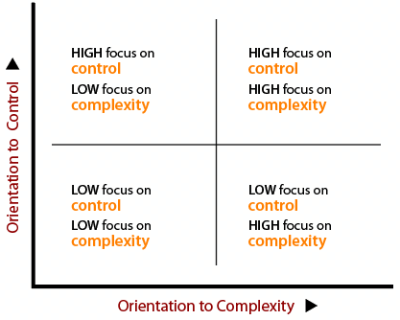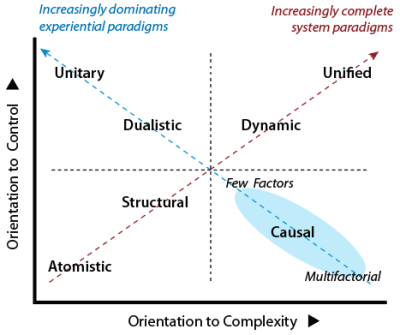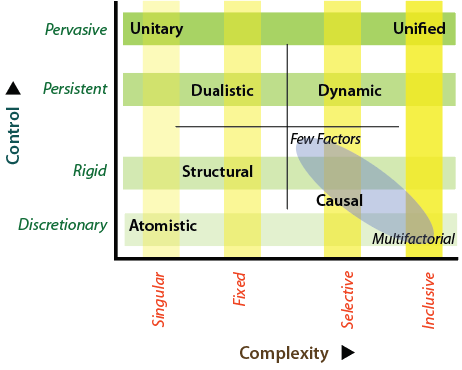Complexity and Control
Naming the TET Axes

In the previous topic, the likely layout of the TET was determined based on taxonomic principles and using resonance as a guide.
We can now consider the formal properties further and label:
- the X- and Y-axes,
so as to get an understanding of the four quadrants and the two diagonals.
The two axes define the psycho-social dimensions that paradigms must take into account to a greater or lesser degree when depicting an entity-situation.
The X-axis determines the social or output dimension affecting the use of any . This appears to be how much the paradigm addresses the complexity of situations.
The Y-axis determines the psychological or input dimension when using any . This appears to be how much the paradigm addresses control of situations.
This then generates a TET with quadrants as shown at right.
Labelling the axes and quadrants in this way makes it possible to see whether the proposed plot fits. If not, either the axes are in error or the plot is in error.

Checking X-Axis Complexity via Diagonals
The diagonal that stretches from lower left (LL) to upper right (UR) depicts entities or situations as bounded and compound . Such entities with internal structures or components are referred to as a system. Any system looks inward but needs to handle its environment. In moving up the diagonal and along the X-Axis, complexity is given progressively more attention. As a result, the coverage of the paradigm is increasingly complete.
The diagonal that stretches from upper left (UL) to lower right (LR) contains unstructured experiential depictions. Moving down the diagonal and along the X-axis progressively increases the orientation to complexity. Correspondingly, moving up the diagonal from LR to UL shows an increasing disinterest, neglect or rejection of the complexity inherent in any situation.

Checking Y-Axis Control via Diagonals
The diagonal that moves upward from lower right (LR) to upper left (UL) contains unstructured experiential depictions that are increasingly oriented to control due to the move up the Y-axis. Control in this set is desired to serve domination and demands the exercise of coercive power.
The diagonal that moves upwards from lower left (LL) to upper right (UR) contains compound entities or systems that are increasingly concerned with control. This concern results from the challenge of increasing comprehensiveness and the desire to shape situations effectively through harnessing evolution.
The Apollonian - Dionysian Duality

Nowhere is it clearer that THEE's approach duality represents contrasting aspects of human nature highlighted by Friedrich Nietzsche in The Birth of Tragedy (1872) as Appollonian and Dionysian:
-
The Appollonian aspect reflects rationality, order and structured
self-awareness. In all TETs, the diagonal that moves from LR to UL is Appollonian. -
The Dionysian aspect reflects emotion, instinct, fusion with the crowd, loss of boundaries. In all TETs, the diagonal that moves from LR to UL is Dionysian.
The Appollonian diagonal contains paradigms call for the creation of boundaries, the careful identification and ordering of elements, the search for completeness. The paradigms are systems demanding careful thought and deliberate methodical effort with concern for efficacy and remediation of errors. This is where the bulk of academic work is focused.
The Dionysian diagonal contains paradigms that are used spontaneously, often almost unthinkingly, or are implicit and taken for granted. They are used to give meaning to situations, which enables crowd acceptance and participation. Being experiential they are subject to egotistic tendencies, most significantly the urge for domination and power. There is no name to this class of paradigms: see more here.
Zones on the Axes
Based on the above descriptions, it is possible to identify zones on the axes and see similarities between otherwise very different paradigms.
Complexity Orientation : X-Axis
On the X-axis, there are four zones which, moving from left to right, show a progression in their capacity and preference for complexity in the situation i.e. in the entity and/or the environment.
|
|
Complexity is singular i.e. just one component or entity. |
|
|
Complexity is fixed i.e. specific and limited components |
|
|
Complexity is selective i.e. multiple components with optional choices. |
|
|
Complexity is inclusive i.e. considers all relevant components |

Control Orientation : Y-Axis
On the Y-axis, there are four zones which, moving from bottom to top, show a progression in their concern for control of the situation. This control may be exercised within the entity or on the environment.
|
|
Control is discretionary i.e. flexible, discontinuous, minimal. |
|
|
Control is rigid i.e. concentrated in specific linkages between components. |
|
|
Control is persistent i.e. to direct the components continuously |
|
|
Control is pervasive i.e. extensive, intensive, permeating. |
Having confirmed and elaborated on the layout, it is now possible to commence an exploration of how the paradigms address various change issues.
- Start with where change is expected to happen: within or without.
Originally posted: 30-Jun-2024. Last amended: 15-July-2025.
